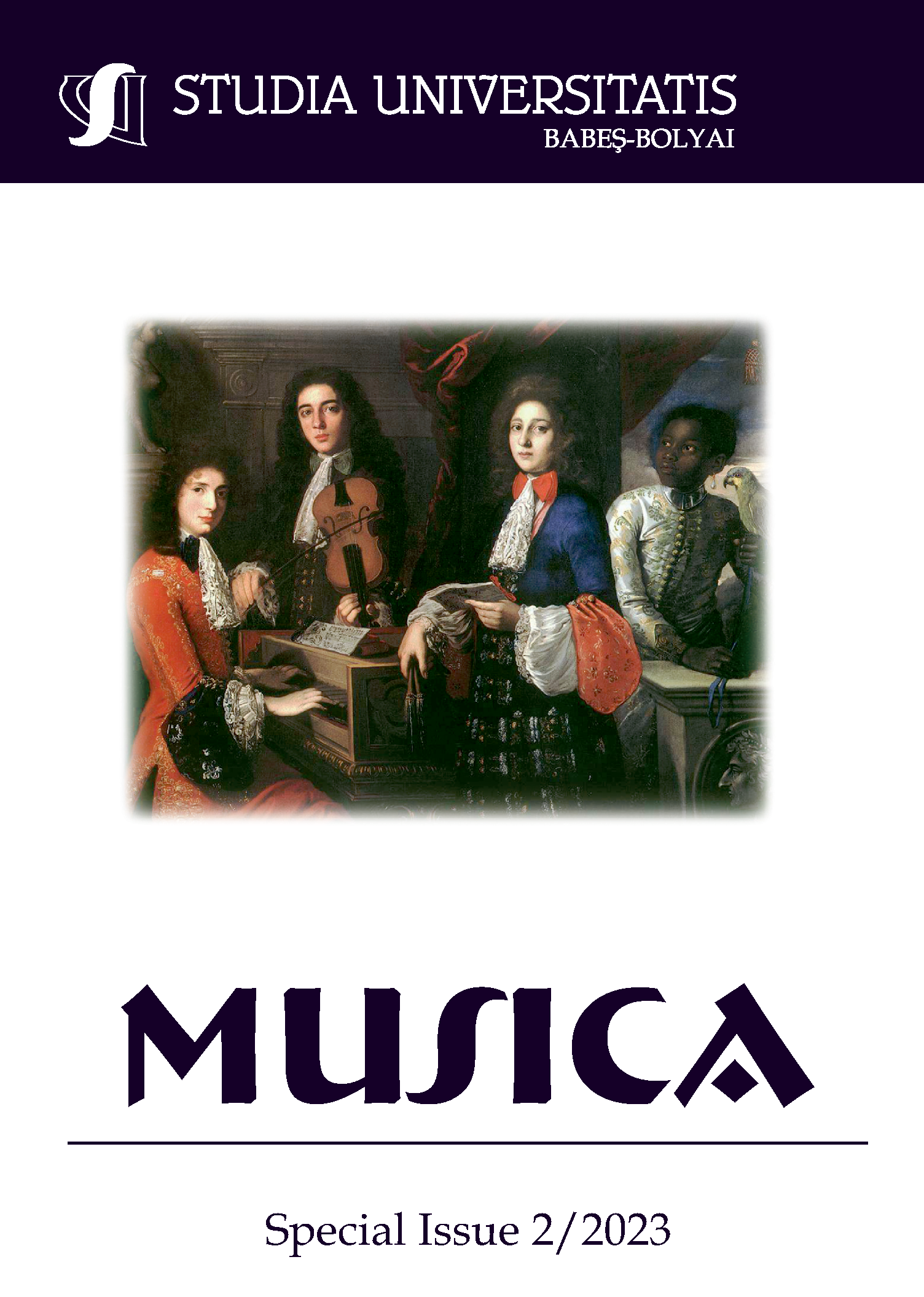TAPPING INTO UNKNOWN MUSICAL AREAS ANALYSIS OF A MEDIEVAL BOHEMIAN MUSICAL MANUSCRIPT
DOI:
https://doi.org/10.24193/subbmusica.2023.spiss2.15Keywords:
Graduale Latino-Bohemicum, musical manuscript, codex, medieval, paleography, Gradual, Cancional, Antifonal, Hussite, Czech, Latin, Gregorian, unison, polyphony.Abstract
This research presents a medieval musical manuscript that has not yet been analyzed in detail. Catalogued under the name of Graduale Latino-Bohemicum, and currently held in the Batthyaneum Library of Alba Iulia, it has many peculiarities in comparison with other similar codices from the Transylvanian area, hence also compared with other Czech manuscripts. We offer analysis around the date of its creation, then debate different naming options. To create the proper context of understanding for the analysis, we present a brief historical background of the time and place in question, that is the turbulent 15th and 16th century of Europe, with special focus on Transylvania. We continue with the physical aspects of the manuscript that guide us through the colorful world of medieval codices. From a structural standpoint the work has two delimited parts. The bilingual manuscript starts with chants written in Czech and finishes with melodies in Latin. The existence of the Czech language, as well as many other clues govern us to set up hypotheses regarding its provenance. During the content analysis we dedicate a subchapter to the later page inserts that contain additional notes for the chants, wherefrom we can further conclude theories about the usage of the codex, authors of the later annotations, and so forth. We offer a more in-depth analysis of the musical notation where aspects like rhythm, staff, neumes used and special solutions are shown. Finally, we conclude all major, raised questions related to the name, origin, and genre.
References
Apel, Willi, The Notation of Polyphonic Music, 900–1600 (5th ed.), Cambridge, MA: The Medieval Academy of America, 1961.
Banciu, Gabriel, Introducere la estetica retoricii muzicale, Cluj-Napoca, 2006, Editura: Media Musica.
Bowers, Roger, Proportional notation. In Sadie, Stanley (ed.), The New Grove Dictionary of Music and Musicians (2nd ed.), London: Grove, 2001.
Bradley, John, Illuminated Manuscripts, London, Bracken Books Publisher, 1996.
Czagány, Zsuzsa, Bemerkungen zum Prager Offizium, in: Miscellanea musicologica XXXVII, Praha, 2003.
Denis, Michael, Codices manuscripti theologici Bibliothecae Palatinae Vindobonensis latini aliarumque occidentis linguarum, vol. I, pars 3, Wien, 1795.
Gecse, Gusztáv, Vallástörténeti kislexikon, Budapesta, Editura Kossuth, 1971.
Gheorghe, I., Năstase, Ungurii din Moldova la 1646 după „Codex Bandinus” (Hungarians in Moldova in 1646 according to the “Codex Bandinus”), Volume IV, Chișinău, „Tiparul Moldovenesc” Publisher, 1935.
Grier, James, The Critical Editing of Music: History, Method and Practice, Cambridge, Cambridge University Press, 1996.
Guido, Maria, Dreves, Cantiones Bohemicae Leiche, Lieder und Rufe des 13., 14. und 15. Jahrhunderts, Leipzig, Fues Press, 1886.
Hefele, Joseph, Karl, A katholikus egyháztörténet tankönyve (Textbook of the Catholic church history), Volume II., Timișoara, Csanád-Egyházmegyei Könyvnyomda, 1905.
Heussi, Karl, Az egyháztörténet kézikönyve, (Kompendium der Kirchengeschichte), Budapest, Osiris, 2000.
Huglo, Michel, Les noms des neumes et leur origine, Etudes grégoriennes, Paris, 1954, Bordas
Kovács, Eszter, Mészáros Andor, Husz János és a huszitizmus hatása a magyarországi művelődésben (Jan Hus și influența husitismului în cultura maghiară), Budapesta, Editura Monobit, 2017
Márton, Szabolcs, “Cantate Domino canticum novum” (Cântați Domnului un cântec nou), Cluj-Napoca, Editura Verbum, 2019.
Radó, Policarpus, Libri liturgici manuscripti bibliothecarum Hungariae et limitropharum regionum, Budapest, Akadémiai Kiadó, 1973.
Szentivány, Robertum, Catalogus concinnus librorum manuscriprorum Bibliothecae Battyányae, Szeged, Editio Quarta Retractata Adaucta Illuminata, 1958.
Tóth-Szabó, Pál, A cseh-huszita mozgalmak és uralom története (History of the Czech-Hussite movements and ruling), Budapest, Hornyánszky, 1917.
Varjú, Elemér, A gyulafehérvári Batthyány-Könyvtár (Biblioteca Batthyány din Alba Iulia), Budapest, Editura Athenaeum, 1899.
Vlhová, Hana, Das Repertorium der Sequenzen in Böhmen bis 1400, Budapest, in: Cantus Planus. International Musicological Society Study Group, 1992.
Web sources
http://esztergom.bibliotheca.hu
https://www.manuscriptorium.com
Downloads
Published
How to Cite
Issue
Section
License
Copyright (c) 2023 Studia Universitatis Babeș-Bolyai Musica

This work is licensed under a Creative Commons Attribution-NonCommercial-NoDerivatives 4.0 International License.



